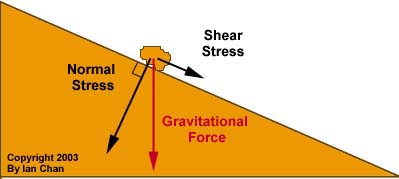|
PHYSICS OF ANGLE OF REPOSE
|
 |
| The balance of forces on a stable slope |
Stable slope and Angle of Repose
The angle of repose is the steepest angle that a stable slope can attain.
In this situation, the force that pulls the particles down the slope (shear stress)
is equal to and balanced by another force that resists the down-slope movement
(shear strength).
Shear Stress on the Slope
Shear stress is the component of gravitational force that is parallel to the slope
and causes particles to move down-slope. The component that is perpendicular to the
slope surface is called the normal stress. It contributes to the friction between the
particles and the surface. Shear stress increases with the angle of the slope, and when
the surface is level there is no shear stress.
 |
| Shear stress on a slope |
|
 |
|
 |
| No shear stress on level ground |
Greater shear stress on steeper slope |
Shear Strength on the Slope
Shear strength is the resistance of particles to move down-slope.
It acts against the shear stress and is determined by the inter-particle friction,
and cohesion, which could be affected by the water content. If the particles on the slope
have larger shear strength, then it could resist more shear stress on a steeper slope,
resulting in a greater angle of repose.
 |
Since rice has higher shear strength, it can resist a higher shear stress at a greater
angle. This is why rice has a higher angle of repose than mung beans in my experiments.
|
↑
Greater shear strength gives rice a greater angle of repose
Weaker shear strength gives mung beans a smaller
angle of repose → |
 |













